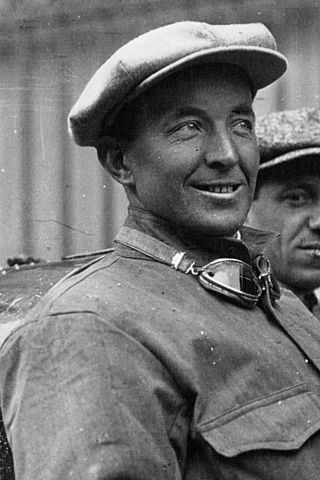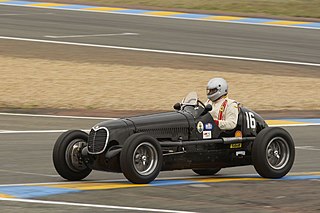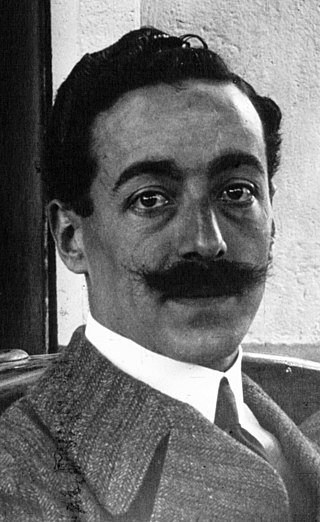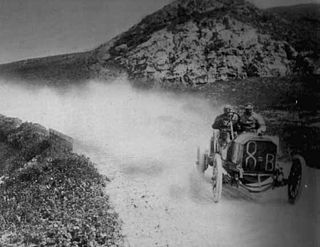
S.P.A. was an Italian automobile, military vehicle and aero-engine manufacturer founded in Turin by Matteo Ceirano and Michele Ansaldi. It was active between 1906 and 1926. In 1908, it merged with Fabbrica Ligure Automobili Genova (FLAG) and the new company, Società Ligure Piemontese Automobili, was headquartered in Genoa while manufacturing in Turin.

Pietro Bordino was an Italian racing driver. One of Italy's top racing drivers of the 1920s, Bordino won the 1922 Italian Grand Prix. One of the few European drivers of the period to compete on the regular American Indy car circuit, comprised largely of board ovals, he won twice during the 1922 U.S. racing season.

The Maserati 6CM is an Italian single-seater racing car, made by Maserati of Modena from 1936 to 1940 for the Voiturette racing class. Twenty-seven were built on the Maserati 4CM frame, with front suspension as on the Maserati V8RI, and had a successful racing career from 1936 to 1939. The 6CM was introduced to the world at the 1936 Milan Motor Show. Maserati spent much of its early years manufacturing cars for privateers in the racing field. The Maserati 6CM is no exception.
The 1906 Grand Prix season is regarded as the first Grand Prix racing season. It marked the advent of two iconic races: The French Grand Prix and the Targa Florio.
The 1907 Grand Prix season was the second Grand Prix racing season. It saw a blossoming of circuit events, with the shift from the inter-city races. The popularity of the inaugural French Grand Prix and Targa Florio saw those events held again. The new Kaiserpreis was the first major motor-race held in Germany. This year also saw a number of voiturette races as the number of specialist small-engine cars grew which gave close, exciting racing very popular with spectators.

The 1908 Grand Prix season was the third Grand Prix racing season. An international economic recession affected motor-racing with fewer races and smaller fields. However, in consequence, it also saw an increase in the number of smaller cars and voiturette racing. This gave close racing between the teams from Lion-Peugeot, Sizaire-Naudin and Delage. Both the major races in Europe, the Targa Florio and French Grand Prix, had precursor voiturette races, and along with the Coupe des Voiturettes, the honours were shared between those three manufacturers. This year’s Targa Florio had a small, but quality, field. Vincenzo Trucco won for Isotta-Fraschini with better mechanical reliability, after a close duel with the FIATs of Felice Nazzaro and Vincenzo Lancia.
The 1910 Grand Prix season was the fifth Grand Prix racing season. Because of the ongoing international economic recession, there were no Grandes Épreuves held. The American Grand Prize was held in Savannah.
The 1912 Grand Prix season saw Grand Prix motor racing in Europe and the United States. The growing economic confidence and interest from car manufacturers saw bigger fields and more races in the season. The French Grand Prix was held for the first time since 1908 and staged at Dieppe. The American Grand Prize was held in Milwaukee, moving from its previous home in Savannah.

The 1914 Grand Prix season consisted of Grand Prix races across Europe and the United States until abbreviated by the outbreak of World War I.

The 1921 Grand Prix season saw motor racing in Europe blossom again. The French Grand Prix was held for the first time since 1914, at La Sarthe, Le Mans. and the inaugural Italian Grand Prix was held in Montichiari, near Brescia. The 3-litre formula of the AIACR, already in use at Indianapolis, was adopted by those Grand Prix meaning manufacturers could design on a common formula.

The 1922 Grand Prix season had several notable events during the year. The AIACR governing body brought in a 2-litre formula for Grand Prix. French companies brought out straight-8 engines for their cars but it was FIAT's 6-cylinder engine that took the trophies. Veteran Felice Nazzaro won the French Grand Prix, held near Strasbourg. It was a tainted victory though, as Nazzaro's nephew was killed when his FIAT's suspension broke in the latter stages of the race. An almost identical accident also happened to team-mate Pietro Bordino, though he was only slightly injured. Pierre de Vizcaya's Bugatti finished second, nearly an hour behind.

The 1923 Grand Prix season was part of a watershed year for motor racing that saw significant advances in motor-racing engineering, design and events. Fiat's chief designer, Guido Fornaca, developed the 805, the first supercharged car to win a Grand Prix. Benz appeared with the first mid-engined racer and, along with Bugatti and Voisin, produced some of the first efforts at aerodynamics on racing cars. With the United States also adopting the 2-litre formula, Harry Miller could use the smaller engine size to design the first single-seater race-car, ideally suited to American oval racing.

The 1924 Grand Prix season saw Grand Prix motor racing spread further across Europe and North America. In Italy a number of new open-road events were held. In France two new circuits were opened – at Montlhéry near Paris and Miramas near Marseille.
The 1920 Grand Prix season saw further activity in motor-racing gradually increase. Europe was still recovering from the end of the war and the terrible pandemic that swept the continent. Automotive companies were gradually re-establishing themselves after re-tooling from a wartime footing and getting production lines rolling again.

The 1909 Grand Prix season was the fourth Grand Prix racing season. There were no Grandes Épreuves that year, as the economic recession of the previous year continued on. Renault had withdrawn from motor-racing and a number of French manufacturers, falling behind the success of their German and Italian rivals, followed suit. The French Grand Prix was cancelled, leaving the Targa Florio in Italy and Vanderbilt Cup in the United States as the only major races this season. With so little competition and financial incentive, technological advances ground to a halt. Emphasis shifted from racing to setting speed and endurance records. Benz & Cie built a new 12.4-litre racing-engine, and its 200 bhp derivative was put into the Blitzen Benz. This 21.5-litre monster held the Land speed record from 1909 to 1922, with various drivers starting with Victor Hémery in November, 1909 at Brooklands.

Alessandro Umberto Cagno, Umberto Cagno, nicknamed Sandrin was an Italian racing driver, Aviation pioneer and powerboat racer.

Fabbrica Junior Torinese d'Automobili, Ceirano Junior, Junior F.J.T.A., was an Italian automobile manufacturer based in Turin which was founded by Giovanni Ceirano in 1905. The Junior, often known as F.J.T.A., was made from 1905 until 1909

The Fiat 28-40 HP, also known as the Fiat Targa Florio Corsa, is a Grand Prix racing car manufactured by Fiat in 1906 and 1907. From 1907 through 1910, the design evolved into commercial production vehicles, including cars, light trucks, and buses.

Automobili Nazzaro was an Italian manufacturer of automobiles from 1911 to 1916, and 1919–1923. Founded by racing driver Felice Nazzaro it produced circa 490 vehicles in total and won both the 1913 and 1920 Targa Florios in Sicily.

The Fiat 804 or 804 Corsa is an early 1920s racing car developed by Italian carmaker Fiat. Designed exclusively for competition, in 1922 it won both the Grand Prix of the Automobile Club of France and the Italian Grand Prix, establishing Fiat's dominance in Grand Prix racing ahead of such prestigious manufacturers as Ballot and Bugatti.
















